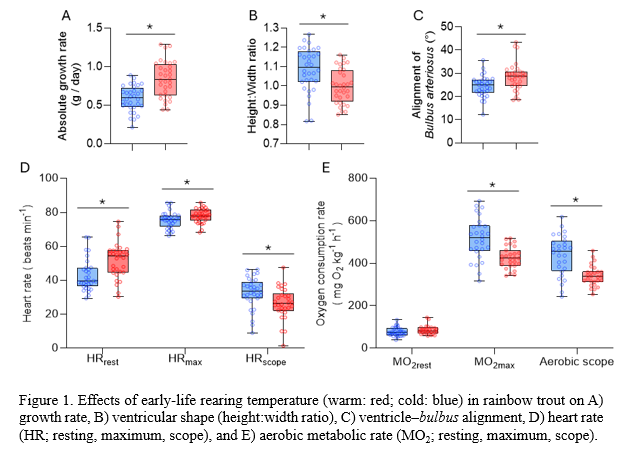RACING TO THE FINISH: HOW EARLY-LIFE WARM REARING UNDERMINES CARDIORESPIRATORY PERFORMANCE AND HEAT TOLERANCE IN RAINBOW TROUT
Background
In salmonid aquaculture, early-life rearing conditions can have long-term effects on fish performance and welfare. Elevated-temperature rearing regimes that promote rapid growth have been linked to increased post-stress mortality, possibly due to misshaped heart morphology observed in both fast-growing Atlantic salmon (Salmo salar) and rainbow trout (Oncorhynchus mykiss) (Brijs et al., 2021; Frisk et al., 2020; Vindas et al., 2024). Additionally, farmed salmonids often exhibit coronary arteriosclerosis causing blockage of coronary artery flow and compromised myocardial oxygen and nutrient supply, a condition that is likely exacerbated by stressful rearing conditions (Brijs et al., 2021). The implications of these cardiovascular pathologies on cardiac and metabolic performance and stress resilience remain unclear. To address this, we investigated cardiorespiratory physiological and cardiac morphological consequences of warm rearing conditions in rainbow trout, raised under two temperature regimes at a commercial fish farm.
Material and methods
Warm- and cold-reared trout (n=32 per group) were raised under temperature regimes differing by 4–10°C for 7–8 months and then acclimated to a common temperature of 10°C for 4–7 weeks. Fish were surgically instrumented with electrodes to monitor heart rate via their electrocardiogram (ECG) and assess cardiac performance. After overnight recovery, heart rate and metabolic rate (via intermittent respirometry) were measured at rest and after an exhaustive chase protocol to attain maximum values. Aerobic scope and heart rate scope (maximum-resting values), reflecting the capacity to increase these performances above resting levels when needed (e.g., during stressful events), were calculated. The following day, fish were subjected to an acute warming protocol to determine critical thermal maximum (CTmax), after which they were euthanized for assessments of heart morphology. We evaluated the shape of the ventricle and the alignment of the bulbus arteriosus, and ongoing analyses will provide information about the prevalence and severity of coronary arteriosclerosis.
Results
Preliminary data show that warm-reared trout had significantly higher growth rates, more rounded ventricles (lower height:width ratio), and a misaligned bulbus arteriosus compared to cold-reared trout (Fig. 1A–C). Warm-reared fish also showed parallel elevations of resting and maximum heart rate (Fig. 1D). This led to a reduced heart rate scope. Furthermore, warm-reared trout had lower aerobic scope due to reduced maximum metabolic rate (Fig. 1E). Heat tolerance was also impaired in warm reared trout, as evidenced by a lower CTmax (26.3°C vs. 27.3°C).
Conclusions
Our findings show that warm rearing accelerates early growth but induces cardiac remodeling linked to impaired heart function, reduced aerobic metabolic capacity, and lowered thermal tolerance in rainbow trout. These physiological impairments may contribute to elevated mortality in aquaculture, particularly during stress from e.g., handling, treatment, and transport. Rearing protocols that prioritize growth should be re-evaluated, as they may compromise fish welfare and overall stress resilience. Ongoing experiments aim to further elucidate the long-term impacts of early-life thermal environments on adult trout health and performance.
References
Brijs, J., Føre, M., Gräns, A., Clark, T. D., Axelsson, M., & Johansen, J. L. (2021). Bio-sensing technologies in aquaculture: how remote monitoring can bring us closer to our farm animals. Philosophical Transactions of the Royal Society B: Biological Sciences, 376(1830), 20200218.
Frisk, M., Høyland, M., Zhang, L., Vindas, M. A., Øverli, Ø., & Johansen, I. B. (2020). Intensive smolt production is associated with deviating cardiac morphology in Atlantic salmon (Salmo salar L.). Aquaculture, 529, 735615.
Vindas, M. A., Engdal, V. A., Kavaliauskiene, S., Folkedal, O., Höglund, E., Moyano, M., Øverli, Ø., Frisk, M., & Johansen, I. B. (2024). Importance of environmental signals for cardiac morphological development in Atlantic salmon. Journal of Experimental Biology, 227(20).
